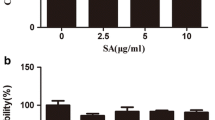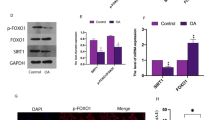Abstract
Chondrocyte apoptosis is an important mechanism involved in osteoarthritis (OA). Berberine (BBR), a plant alkaloid derived from Chinese medicine, is characterized by multiple pharmacological effects, such as anti-inflammatory and anti-apoptotic activities. This study aimed to evaluate the chondroprotective effect and underlying mechanisms of BBR on sodium nitroprusside (SNP)-stimulated chondrocyte apoptosis and surgically-induced rat OA model. The in vitro results revealed that BBR suppressed SNP-stimulated chondrocyte apoptosis as well as cytoskeletal remodeling, down-regulated expressions of inducible nitric oxide synthase (iNOS) and caspase-3, and up-regulated Bcl-2/Bax ratio and Type II collagen (Col II) at protein levels, which were accompanied by increased adenosine monophosphate-activated protein kinase (AMPK) phosphorylation and decreased phosphorylation of p38 mitogen-activated protein kinase (MAPK). Furthermore, the anti-apoptotic effect of BBR was blocked by AMPK inhibitor Compound C (CC) and adenosine-9-β-D-arabino-furanoside (Ara A), and enhanced by p38 MAPK inhibitor SB203580. In vivo experiment suggested that BBR ameliorated cartilage degeneration and exhibited an anti-apoptotic effect on articular cartilage in a rat OA model, as demonstrated by histological analyses, TUNEL assay and immunohistochemical analyses of caspase-3, Bcl-2 and Bax expressions. These findings suggest that BBR suppresses SNP-stimulated chondrocyte apoptosis and ameliorates cartilage degeneration via activating AMPK signaling and suppressing p38 MAPK activity.








Similar content being viewed by others
References
Aicher WK, Rolauffs B (2014) The spatial organisation of joint surface chondrocytes: review of its potential roles in tissue functioning, disease and early, preclinical diagnosis of osteoarthritis. Ann Rheum Dis 73:645–653
Thysen S, Luyten FP, Lories RJ (2015) Targets, models and challenges in osteoarthritis research. Dis Model Mech 8:17–30
Johnson VL, Hunter DJ (2014) The epidemiology of osteoarthritis. Best Pract Res Clin Rheumatol 28:5–15
Terkeltaub R, Yang B, Lotz M, Liu-Bryan R (2011) Chondrocyte AMP-activated protein kinase activity suppresses matrix degradation responses to proinflammatory cytokines interleukin-1beta and tumor necrosis factor alpha. Arthritis Rheum 63:1928–1937
Wang X, Hunter D, Xu J, Ding C (2015) Metabolic triggered inflammation in osteoarthritis. Osteoarthritis Cartilage 23:22–30
Liu-Bryan R, Terkeltaub R (2015) Emerging regulators of the inflammatory process in osteoarthritis. Nat Rev Rheumatol 11:35–44
Lee AS, Ellman MB, Yan D, Kroin JS, Cole BJ et al (2013) A current review of molecular mechanisms regarding osteoarthritis and pain. Gene 527:440–447
Liang Q, Wang XP, Chen TS (2014) Resveratrol protects rabbit articular chondrocyte against sodium nitroprusside-induced apoptosis via scavenging ROS. Apoptosis 19:1354–1363
Ryu JS, Jung YH, Cho MY, Yeo JE, Choi YJ et al (2014) Co-culture with human synovium-derived mesenchymal stem cells inhibits inflammatory activity and increases cell proliferation of sodium nitroprusside-stimulated chondrocytes. Biochem Biophys Res Commun 447:715–720
Uehara Y, Hirose J, Yamabe S, Okamoto N, Okada T et al (2014) Endoplasmic reticulum stress-induced apoptosis contributes to articular cartilage degeneration via C/EBP homologous protein. Osteoarthritis Cartilage 22:1007–1017
Hui W, Young DA, Rowan AD, Xu X, Cawston TE, et al (2014) Oxidative changes and signalling pathways are pivotal in initiating age-related changes in articular cartilage. Ann Rheum Dis. doi:10.1136/annrheumdis-2014-206295
Battistelli M, Salucci S, Olivotto E, Facchini A, Minguzzi M et al (2014) Cell death in human articular chondrocyte: a morpho-functional study in micromass model. Apoptosis 19:1471–1483
Mihaylova MM, Shaw RJ (2011) The AMPK signalling pathway coordinates cell growth, autophagy and metabolism. Nat Cell Biol 13:1016–1023
Dasgupta B, Milbrandt J (2007) Resveratrol stimulates AMP kinase activity in neurons. Proc Natl Acad Sci USA 104:7217–7222
Kang EH, Lee YJ, Kim TK, Chang CB, Chung JH et al (2010) Adiponectin is a potential catabolic mediator in osteoarthritis cartilage. Arthritis Res Ther 12:R231
She C, Zhu LQ, Zhen YF, Wang XD, Dong QR (2014) Activation of AMPK protects against hydrogen peroxide-induced osteoblast apoptosis through autophagy induction and NADPH maintenance: new implications for osteonecrosis treatment? Cell Signal 26:1–8
Kong D, Zheng T, Zhang M, Wang D, Du S et al (2013) Static mechanical stress induces apoptosis in rat endplate chondrocytes through MAPK and mitochondria-dependent caspase activation signaling pathways. PLoS ONE 8:e69403
Abella V, Santoro A, Scotece M, Conde J, Lopez-Lopez V et al (2015) Non-dioxin-like polychlorinated biphenyls (PCB 101, PCB 153 and PCB 180) induce chondrocyte cell death through multiple pathways. Toxicol Lett 234:13–19
Rasheed Z, Akhtar N, Haqqi TM (2010) Pomegranate extract inhibits the interleukin-1beta-induced activation of MKK-3, p38alpha-MAPK and transcription factor RUNX-2 in human osteoarthritis chondrocytes. Arthritis Res Ther 12:R195
Kong W, Wei J, Abidi P, Lin M, Inaba S et al (2004) Berberine is a novel cholesterol-lowering drug working through a unique mechanism distinct from statins. Nat Med 10:1344–1351
Qiu G, Song YH, Zeng P, Duan L, Xiao S (2013) Characterization of bacterial communities in hybrid upflow anaerobic sludge blanket (UASB)-membrane bioreactor (MBR) process for berberine antibiotic wastewater treatment. Bioresour Technol 142:52–62
Mo C, Wang L, Zhang J, Numazawa S, Tang H et al (2014) The crosstalk between Nrf2 and AMPK signal pathways is important for the anti-inflammatory effect of berberine in LPS-stimulated macrophages and endotoxin-shocked mice. Antioxid Redox Signal 20:574–588
Tsang CM, Cheung YC, Lui VW, Yip YL, Zhang G et al (2013) Berberine suppresses tumorigenicity and growth of nasopharyngeal carcinoma cells by inhibiting STAT3 activation induced by tumor associated fibroblasts. BMC Cancer 13:619
Zhang YJ, Yang SH, Li MH, Iqbal J, Bourantas CV et al (2014) Berberine attenuates adverse left ventricular remodeling and cardiac dysfunction after acute myocardial infarction in rats: role of autophagy. Clin Exp Pharmacol Physiol 41:995–1002
Domitrovic R, Cvijanovic O, Pernjak-Pugel E, Skoda M, Mikelic L et al (2013) Berberine exerts nephroprotective effect against cisplatin-induced kidney damage through inhibition of oxidative/nitrosative stress, inflammation, autophagy and apoptosis. Food Chem Toxicol 62:397–406
Moon PD, Jeong HS, Chun CS, Kim HM (2011) Baekjeolyusin-tang and its active component berberine block the release of collagen and proteoglycan from IL-1beta-stimulated rabbit cartilage and down-regulate matrix metalloproteinases in rabbit chondrocytes. Phytother Res 25:844–850
Hu PF, Chen WP, Tang JL, Bao JP, Wu LD (2011) Protective effects of berberine in an experimental rat osteoarthritis model. Phytother Res 25:878–885
Zhao H, Zhang T, Xia C, Shi L, Wang S et al (2014) Berberine ameliorates cartilage degeneration in interleukin-1beta-stimulated rat chondrocytes and in a rat model of osteoarthritis via Akt signalling. J Cell Mol Med 18:283–292
Hayami T, Pickarski M, Zhuo Y, Wesolowski GA, Rodan GA et al (2006) Characterization of articular cartilage and subchondral bone changes in the rat anterior cruciate ligament transection and meniscectomized models of osteoarthritis. Bone 38:234–243
Wang CJ, Huang CY, Hsu SL, Chen JH, Cheng JH (2014) Extracorporeal shockwave therapy in osteoporotic osteoarthritis of the knee in rats: an experiment in animals. Arthritis Res Ther 16:R139
Rautiainen J, Nissi MJ, Liimatainen T, Herzog W, Korhonen RK et al (2014) Adiabatic rotating frame relaxation of MRI reveals early cartilage degeneration in a rabbit model of anterior cruciate ligament transection. Osteoarthr Cartil 22:1444–1452
Simoes Pires EN, Frozza RL, Hoppe JB, Menezes Bde M, Salbego CG (2014) Berberine was neuroprotective against an in vitro model of brain ischemia: survival and apoptosis pathways involved. Brain Res 1557:26–33
Li MH, Zhang YJ, Yu YH, Yang SH, Iqbal J et al (2014) Berberine improves pressure overload-induced cardiac hypertrophy and dysfunction through enhanced autophagy. Eur J Pharmacol 728:67–76
Wang F, Wu L, Li L, Chen S (2014) Monotropein exerts protective effects against IL-1beta-induced apoptosis and catabolic responses on osteoarthritis chondrocytes. Int Immunopharmacol 23:575–580
Maia-de-Oliveira JP, Lobao-Soares B, Baker GB, Dursun SM, Hallak JE (2014) Sodium nitroprusside, a nitric oxide donor for novel treatment of schizophrenia, may also modulate dopaminergic systems. Schizophr Res 159:558–559
Guo S, Ashina M, Olesen J, Birk S (2013) The effect of sodium nitroprusside on cerebral hemodynamics and headache in healthy subjects. Cephalalgia 33:301–307
Hu Z, Jiao Q, Ding J, Liu F, Liu R et al (2011) Berberine induces dendritic cell apoptosis and has therapeutic potential for rheumatoid arthritis. Arthritis Rheum 63:949–959
Pandareesh MD, Anand T (2014) Neuroprotective and anti-apoptotic propensity of Bacopa monniera extract against sodium nitroprusside induced activation of iNOS, heat shock proteins and apoptotic markers in PC12 cells. Neurochem Res 39:800–814
de Andres MC, Maneiro E, Martin MA, Arenas J, Blanco FJ (2013) Nitric oxide compounds have different effects profiles on human articular chondrocyte metabolism. Arthritis Res Ther 15:R115
Haudenschild DR, Chen J, Pang N, Steklov N, Grogan SP et al (2011) Vimentin contributes to changes in chondrocyte stiffness in osteoarthritis. J Orthop Res 29:20–25
Gomez R, Conde J, Scotece M, Lopez V, Lago F et al (2014) Endogenous cannabinoid anandamide impairs cell growth and induces apoptosis in chondrocytes. J Orthop Res 32:1137–1146
Husa M, Petursson F, Lotz M, Terkeltaub R, Liu-Bryan R (2013) C/EBP homologous protein drives pro-catabolic responses in chondrocytes. Arthritis Res Ther 15:R218
Wang Y, Huang Y, Lam KS, Li Y, Wong WT et al (2009) Berberine prevents hyperglycemia-induced endothelial injury and enhances vasodilatation via adenosine monophosphate-activated protein kinase and endothelial nitric oxide synthase. Cardiovasc Res 82:484–492
Chen K, Li G, Geng F, Zhang Z, Li J et al (2014) Berberine reduces ischemia/reperfusion-induced myocardial apoptosis via activating AMPK and PI3 K-Akt signaling in diabetic rats. Apoptosis 19:946–957
Yan F, Wang L, Shi Y, Cao H, Liu L et al (2012) Berberine promotes recovery of colitis and inhibits inflammatory responses in colonic macrophages and epithelial cells in DSS-treated mice. Am J Physiol Gastrointest Liver Physiol 302:G504–G514
Acknowledgments
We gratefully acknowledge Erping Yang for his excellent technical assistance.
Author information
Authors and Affiliations
Corresponding author
Ethics declarations
Conflict of interest
All authors declared no potential conflicts of interest.
Rights and permissions
About this article
Cite this article
Zhou, Y., Liu, SQ., Yu, L. et al. Berberine prevents nitric oxide-induced rat chondrocyte apoptosis and cartilage degeneration in a rat osteoarthritis model via AMPK and p38 MAPK signaling. Apoptosis 20, 1187–1199 (2015). https://doi.org/10.1007/s10495-015-1152-y
Published:
Issue Date:
DOI: https://doi.org/10.1007/s10495-015-1152-y




